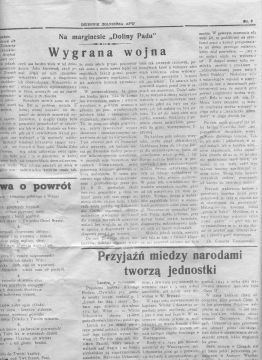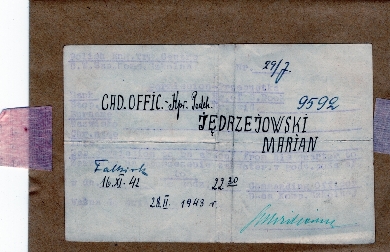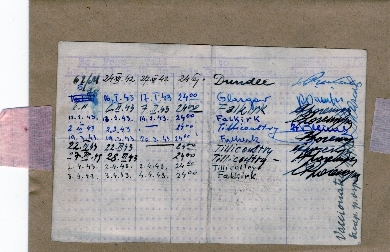Click on any picture for full size and description. Use dots to navigate between gallery pages…

This is the front view of the standard British 64 paybook issued to all British/Commonwealth and Canadian soldiers. The Poles also used this as a form of identification with Polish language modifications
British 64 Paybook - Imperowicz

Page 2 of 64 Paybook for Jan Imperowicz, DOB April 18, 1899. Notice it lists his city of birth as Wilno, however in 1899 this was part of Lithuania until Poland annexed it in the early 20's. Also of note is that all entries under "Territorial, Supplementary and Army Reserve" have been struck out and Polish "Regular Army" are added. See also that his personal picture is not and was never added to page 3.
British 64 Paybook - Imperowicz

Extensive documentation under the medical section. Notice how important annotations such as "blood group" have been provided in English as well as Polish.
British 64 Paybook - Imperowicz
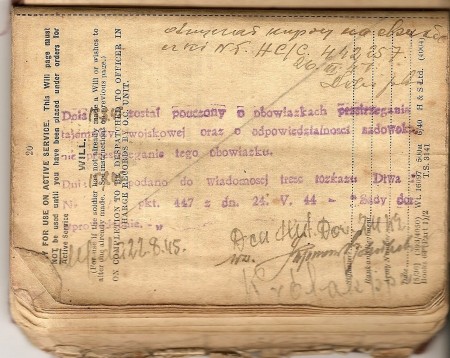
Miscellaneous entries mostly post war. One indicates some form of security clearance held.
British 64 Paybook - Imperowicz

Another example of a standard 64 Paybook from Cpl. Jozef Biega, DOB Dec 13, 1925. Notice also his place of birth has been inked out so as not to endanger his family living in occupied Poland if captured. Unlike Imperowicz's paybook Biega's specifically shows his discharge status and PRC date.
British 64 Paybook - Biega
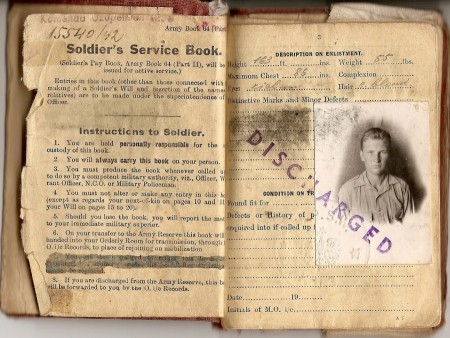
Here we see how Biega's book differs from Imperowicz in that Jozef's picture is included on page 3. Also of note are that his physical data is entered in metric measurements and not the English standard system as annotated. An embossed 2nd Corps stamp is clearly visible on the original lower corner.
British 64 Paybook - Biega

Notice here Biega's periods of R&R after the shooting war ended have been annotated here. This is the only example of an entry of this nature I've ever seen.
British 64 Paybook - Biega

A long list of medical vaccinations and treatments initially as Biega had come from forced labour in Siberia and was malnourished and in poor health.
British 64 Paybook - Biega

Examples of more post war and PRC annotations. Take note of official stamp indicating he was authorized to draw three army issue handkerchiefs upon discharge. A sad postscript to a soldier's youth given in defense of world freedom.
British 64 Paybook - Biega
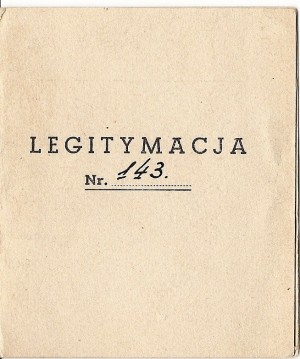
A brief explanation of Polish legitymacja documents:
All badges or medals issued by the army to an individual were accompanied by a document authorizing the bearer to wear the referenced decoration. These documents were often made of heavy weight paper, about the thickness of a standard business card. Most soldiers carried these cards in pockets on the rear flap of the 64 Paybook. Front side of legitymacja for Cpl. Biega.
Legitymacja Documents
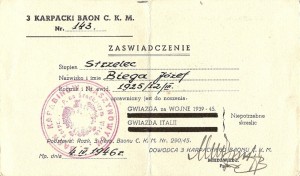
Interior of same indicating Biega as a member of the 3rd Carpathian Division Machine gun support battalion.
Legitymacja Documents

Scan of front and back of another legitymacja. This authorized Cpl. Biega to wear the official divisional badge on his left tunic pocket.
Legitymacja Documents

Interior scan of same. Notice annotations of famous battles the Carpathian's fought to include defense of Tobruk. Signed for General Duch, commander of the 3rd Div.
Legitymacja Documents

Front scan of legitymacja to authorize Cpl. Biega to wear the driver's qualification badge on his tunic.
Legitymacja Documents

Interior of driver's qual badge confirming Biega had taken and passed the necessary training and testing to receive this badge of distinction. Jozef had been specially trained to drive the Universal carrier MkII to transport his Vickers machine gun section.
Legitymacja Documents

Examples of standard British issue identity disks as issue to Polish soldiers. This set belonged to Tadeusz Wisniweski. It annotates he was in the "AP" Armia Polski born in 1926 and of Roman Catholic faith.
Identity Disks

This is the paybook for Kazimierz Barut. As you can see from the photo he was very young upon enlistment in the 2nd Corps on Soviet soil. The following documents are very interesting as they represent some extremely early documentation as well as some answers to later awards.
Paybook - Kazimierz Barut
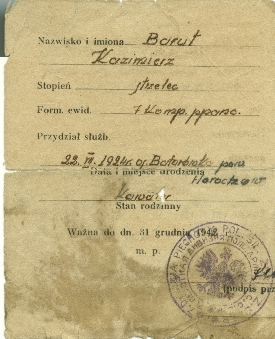
This is the earliest document I have ever seen issued to a member of the Polish army while in the USSR. It's basically an early form of ID which details Kazik as a member of the newly formed Polish army. Notice the Russian writing.
USSR ID Booklet - Kazimierz Barut
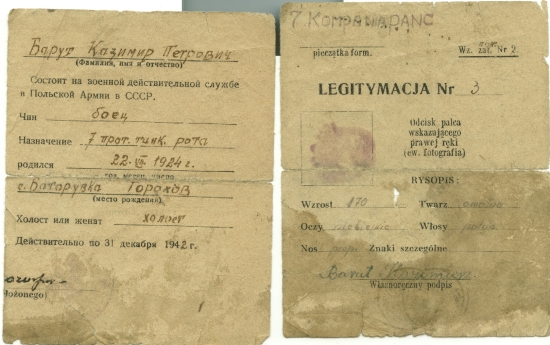
Here we see the interior pages of the identification booklet. Needless to say such paperwork was essential when the Polish army members were still on very unfriendly soil within the USSR. As I have heard from numerous vets and read in many documents, even when the "amnesty" was officially announced, many camp commissars were loathe to release their Polish slave labor. Therefore any official documentation one could provide was worth it's weight in gold.
USSR ID Booklet - Kazimierz Barut

I find these two pieces of documentation very interesting. The one atop is authorization for Kazik to wear a 2nd Corps shield on his uniform. The bottom is the interior of his legitymacja for his unit badge which was the 7th Anti-tank Regiment. Notice the dates on both of these. They are after the shooting war has officially ended. His 7th A-tk badge is only number 39 which means he was one of the first troops to be issued it. This information helps piece together the puzzle often asked by unit historians as to when many of the extra badges we sometimes see on uniforms actually came out. I have long thought that the majority of insignia was most likely a post shooting war addition. This helps us attempt to date photos that have no documentation associated with them.
Legitymacja Documents - Kazimierz Barut

Here are views of the front pieces of the two aforementioned documents.
Legitymacja Documents - Kazimierz Barut

Here is a detailed look at some of the metal insignia from Kazik's uniform. The shield on the right is his 7th Anti tank regiment badge. The enameled collar pennons are also a post war, private purchase uniform addition. Originally the pennons for his unit would have been a cloth material. Enamel collar devices appear to be mostly worn on units coming from Italy. I have not seen the proliferation of enamel devices within 1st corps personnel.
Collar Tabs - Kazimierz Barut

This original invasion currency was carried by then Lt. Jan Karcz of the 10th Dragoon Regt during the Normandy campaign. Currency such as this was issued to all troops operating in France so that other national currency would not flood through the country and end up in the black market. This bill was present at the battle of Chambois during the Falaise Gap battle. A very interesting piece of history the donation of which we are very grateful to the family of the late LtCol. Karcz.
Invasion Currency

This is a scan from the top half, of the first page of the Polish army newspaper dated November 28, 1944.
Polish Army Newspaper

This is the bottom half of the 1st page. Unfortunately the scanner is not large enough to allow for a complete
image of the paper. The following pictures have been provided to give the reader an idea of the types of subject material reported on.
Polish Army Newspaper

The total number of pages in this edition was four. From the other examples I've seen, this appears to be the typical number.
Polish Army Newspaper

A front and rear view of an original pass for a Corporal Cadet Officer relatively early in the division's stay in the UK 1942.
Polish Passes / Leave Permits

